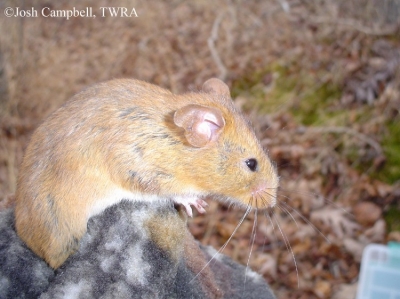Golden Mouse, Ochrotomys nuttalli
The Golden Mouse, which occurs state-wide, has a distinctive yellow coloration distinguishing it from all other mice in Tennessee.
Description:
A small, yellowish to orange-brown mouse with large, black eyes, prominent ears, and long whiskers. The feet and belly are mostly white with some yellowish color. The feet are small to aid in climbing. Tails are well-furred and about one-half (or a little less) the total length of the body. Golden mice lack a sharp contrast in color between back and belly, and upper tail and lower tail.
Length: 5.0 - 8.0 inches
Tail: 2.0 - 4.0 inches
Ears: 0.5 - 0.8 inches
Weight: 0.5 - 1.0 ounces
Similar Species:
Can be distinguished from the similar Peromyscus species by its golden color.
Habitat:
Golden mice occupy a variety of habitats, but generally prefer moist thickets, forests, and borders of broomsedge fields, especially containing vines and dense underbrush.
Diet:
Key items include seeds, acorns, fruit, and some insects. Sumac, greenbriar, and wild cherry seeds are favorites.
Breeding information:
They breed from spring to fall, with fall litters averaging larger sizes. One to four young per litter are born after a pregnancy lasting 25-30 days. Young are born without fur, teeth, or vision, but are weaned after only 3 weeks.
Status in Tennessee:
Although this is an uncommon species, it is not one of conservation concern.
Fun Facts:
•These arboreal mice build spherical nests, made of leaves, bark, and grass, up to 15 feet above ground in bushes, vines, or hollow trees.
•As many as 8 Golden mice can huddle together in a nest to keep warm on a winter night.
Best places to see in Tennessee:
Edges of broomsedge fields with vines and dense vegetation.
